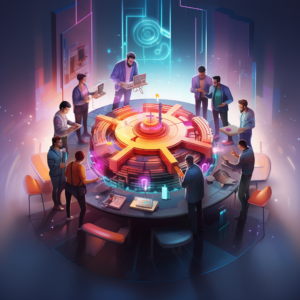Judgement and Decision-Making Part 2: Individual and Group Decisions
Today we continue our series on Judgement and Decision Making. In our last article we looked at the decision-making process and the biases we confront in arriving at a decision. We discussed how individual decision makers are subject to many cognitive distortions and how self-awareness can help decision makers take steps to negate these distortions.
In this article, we explore the role of personality traits in decision-making, the limitations of analytical decisions and the differences between individual and group decision-making.
Attributes of an Effective Decision Maker
In addition to the decision makers level of domain experience, knowledge, and expertise there are several personality traits that indicate a propensity for good or bad decision making.
Personality traits considered indicators of good decision-making ability include an Internal Locus of Control, Flexibility in Thinking, Sense of Responsibility, Self-Acceptance, Self- Awareness and Critical Thinking. Conversely traits that are indicators of poor decision-making ability are Impulsiveness, Procrastination, Rigidity in Thinking, Anxiety, Depression, and an Inclination of Conformity.
The expression of these traits and their aggregate influence over decision-making within individuals is in constant flux. As decision-makers we should be aware of their influence and acknowledge that our abilities may be hindered when we are displaying negative traits.
Analytical Decisions and their Limitations in the Business Environment
Engineers like systematic analytical decision frameworks based on probabilistic outcomes. These frameworks use Decision Trees or Bayes Block Diagrams to represent the likely outcome of various events. Decision made in this manner follow the Expected Utility Theory which assumes that decision makers are rational and always seek to maximise value (or utility). The utility of a decision is calculated by multiplying the probability with the expected pay-off.
Unfortunately, in the real-world problems are too complex to present in neat decision trees. Due to incomplete information the probabilities and pay-offs are typically determined using inference and assumption which are highly susceptible to cognitive distortions and biases. As an example, people are much more motivated by loss aversion than potential gain. Where probabilities and pay-offs are not established using statistical and quantitative data but rather assumption and intuition, they provide false assurances for the decision-maker that the analysis is accuracy.
Due to these limitations on analytical decision-making other methods such as holistic decision making must be used in the business environment.
Individual Decision Making
The holistic decision-making process was described in the previous article. To recap this process follows this sequence Goal -> Problem or Opportunity -> Cognition -> Judgement -> Decision. Holistic decision-making acknowledges that decision makers utilise many mental models to evaluate options and arrive at a decision. Key among these are:
Reasoned Choice – This model aims for an optimal choice via fully rational reasoning. Reasoned choice requires sufficient time and resources for information collation and analysis. It is most useful where decision must be justified to many stakeholders. This model assumes the decision maker has detailed knowledge of many alternatives, clear understanding of the consequences, has consistent preferences and a decision rules. In practice these assumptions generally do not hold, despite this the model is still useful but the decision may not be optimal.
Image Theory – This theory proposes that decision makers adopt plans to achieve goals based on personal and organisational values. With most decisions made based on doing what is right rather than a desire for an optimal solution. Solutions are to problems evaluated against held values and organisational norms. Solutions that are compatible are adopted.
Recognition Primed Judgement – With this model an expert draws on their experience and skill to recognise the situation or problem they are facing. From here the person can make quick judgements as to likely causes and how the situation will develop. This then allows the expert to run mental simulations of the suitability of typical or practical solutions. If a solution is deemed satisfactory it is adopted immediately. This approach finds a fast and reasonable solution when employed by a domain expert. This approach is only appropriate where the decision maker finds themselves in a familiar situation in their field of expertise.
In many circumstances decision making is constrained by an individual’s expertise or knowledge. In these instances, group decision making will yield better outcomes.
Group Decision Making
Research has shown that group-level decisions demonstrate greater accuracy than individual decisions. Groups, vs individuals working alone, more frequently reach correct solutions, make better hiring decisions, perform better in negotiation, provide more accurate forecasts, generate more creative ideas, perform better on academic tests, and more accurately recall information. However, group decision making does have several limitations such as:
- Group Decisions are Slow – Compared with individual processing and decision making the process of arriving at a decision can be much less efficient. This is particularly and issue where rapid decision making is required.
- Groups Conform – is the process of changing one’s behaviour or beliefs to fit in with the group. Here the majority can be heavily influenced by a small number of confident and influential people. This can lead the group to do things they wouldn’t consider doing as an individual. A non-conformist can be vital here off-setting undue influence. Conversely the non-conformance can also be an agitator that sways the majority and prevents group consensus.
- Groups Polarise Opinions – Where decisions involve discrete choice, groups will tend to adopt a more extreme position of the solution favoured by majority. Thus, a group can make a good decision better or a bad decision worse.
- Groupthink – is a process of irrational-decision making by a group. Dissenting voices are silenced, only favourable information is presented, people self-censor and groups adopt unquestioned beliefs. These circumstances lead to poor decisions.
When group decision making is conducted using the right model it consistently yields better results than individual decision making. Below we will explore three models where group decision making is particularly beneficial.
Simple Aggregation – In this setting we have no interaction of group members. Each person provides their judgement (likely anonymously). In these settings the average of the group members judgements is more accurate than individuals. This observation is known as the “Wisdom of Crowds”. With accuracy increasing as group size increases. With this model group members in effect all operate as individual decision makers, with a large enough group the aggregation of various responses corrects for individual errors and asymmetrical information sharing. Surveys and Elections are good examples of where this group-decision making model is employed.
Judge-Advisor System – This model is commonly used in the management setting. Here a single decision maker draws on inputs from multiple advisors. Decision quality is improved by these additional inputs; however, the judge still discounts the advice of others compared with their own views and judgements (recall the overconfidence distortion). The level of discounting depends on several factors that have little to do with the actual accuracy of the advisor’s competence such as: Judge’s level of trusts in the advisor and whether the advice was requested or unsolicited.
Group Consensus with Information Sharing – In this model all information is shared with all group members groups. Research has shown that in these circumstances the group easily finds the superior outcome, when compared with groups experiencing asymmetrical information sharing.
Asymmetric information sharing hinders this decision-making model in the following ways;
- Negotiation bias – leads to a focus on outcomes and not the accuracy or completeness of the information underpinning those outcomes.
- Discussion bias – shared information gets discussed making people think that unshared information they have is not important.
- Evaluation bias – shared information is viewed more positively this leads people to think that unshared information they have is not beneficial.
For this type of group decision making to be successful there needs to be a shared focus on decision accuracy over group consensus, and a commitment by free sharing of information as it becomes available to any group member. When these measures are in place this group decision model returns improved accuracy over simple group aggregation and individual decision-making models.
Summing Up
Decision-making is a complex process that involves a combination of individual traits, analytical and intuitive thinking, and group dynamics. Understanding these elements and using them efficiently can significantly enhance the decision-making process and improve project outcomes. The key is to balance the strengths and limitations of individual and group decision-making processes and using the correct approach for each problem.
In the next article we will pull everything together and present decision frameworks for the professional both within and outside of their domain of expertise.
References – Parkin, J (1996), Management Decisions for Engineers;
Group Decision-Making | Oxford Research Encyclopedia of Psychology;
Groupthink: Definition, Signs, Examples, and How to Avoid It (verywellmind.com)



